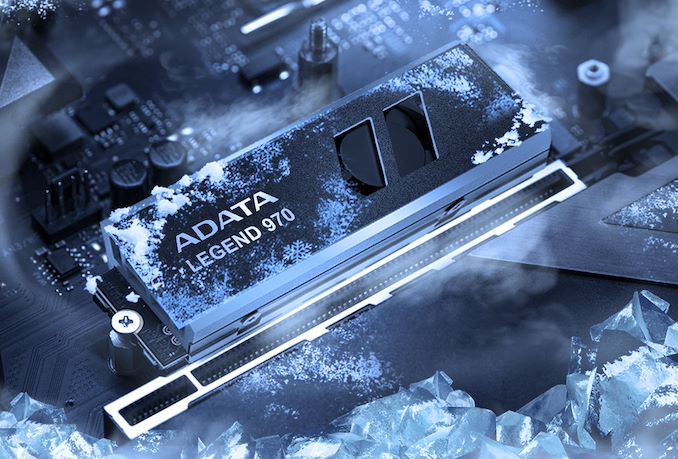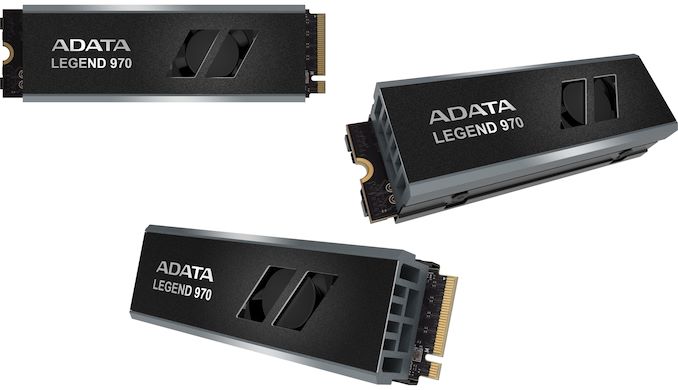Adata Reveals Its First PCIe Gen5 SSD: Legend 970
by Anton Shilov on July 6, 2023 7:30 PM EST
Adata has introduced its first PCIe 5.0 SSD, the Legend 970. A Phison E26-based design, the Legend 970 pairs Phison's high-end controller with a sophisticated active cooling system that promises predictable performance even under high loads. The Legend 970 SSD is aimed at high-performance desktops that can take advantage of fast storage devices.
Adata's Legend 970 drives come in 1 TB and 2 TB capacities and are rated for an up to 10,000 MB/s sequential read/write speed as well as a 1.4 million random read/write IOPS, performance levels in line with those of many current-generation enterprise-grade SSDs. The drives fully support all modern SSD technologies that one comes to expect from a contemporary drive, including SLC cache, Low Density Parity Check Code (LDPC) error correction, and AES 256-bit high-level encryption.
Like other PCIe Gen 5 SSDs available now, the Legend 970 product uses Phison's PS5026-E26 controller. As for memory, the drives use Micron's 232-layer TLC NAND with a 1600 MT/s interface.
One of the key selling points of Adata's Legend 970 is its cooling system, which although a bit on the bulky side of matters, is designed to be robust enough to keep the drive from thermal throttling even under high, sustained loads. Though at 80.6×24.2×17.9mm in size, the resulting SSD is decided a desktop part – and even then the drive will need a fair bit of clearance to fit.
Adata's iniital Legend 970 SSD will eventually be joined by at least one other PCIe 5.0 SSD as well. The company's XPG division is working on their NeonStorm SSD, which uses a self-contained liquid cooling system, and is rated for read speeds of up to 14GB/second (thanks to TLC NAND with a 2400 MT/s interface).
Adata's Legend 970 drives will come with a five-year global warranty. The company hasn't published any pricing information, though we'd expect the drives to be more or less in line with other first-generation PCIe Gen5 SSDs.
Source: Adata











26 Comments
View All Comments
sonny73n - Wednesday, July 12, 2023 - link
Cooling is a must. I just bought a Gen4 m.2 and have it installed in the same system with a Gen3. Both with the same aftermarket heatsinks. The Gen4 is 10C higher idle and 15C higher under load. Gen5 is probably much hotter. Hence the stupid little fan.2TB Gen4 for $85 but I wish I could've gotten a Gen3 instead.
bansheexyz - Friday, July 7, 2023 - link
Ok we may need to slow down a bit here. Trying to make ssds faster without shrinking the controller die is resulting in giant heatsinks and fans lol.nandnandnand - Friday, July 7, 2023 - link
Just put it inside a glacier like that concept art.watersb - Saturday, July 8, 2023 - link
They want you to think the concept photo features water ice, but on the SSD itself? STEAMtwotwotwo - Saturday, July 8, 2023 - link
I wonder how many of these with big coolers sell; the early-adopter tax has been a thing for prior gens, but also mucking up the form factor is a bit more than that. There also seem to be plenty that run fine without a fan or large heatsink!PeachNCream - Friday, July 7, 2023 - link
The intake vent for the "doomed-to-fail-in-2-months" fan is shaped stupidly to interfere with its ability to move air thanks to the partial obstruction of the silly shape. I absolutely wouldn't want to buy something like this that appears to rely on notoriously unreliable active cooling (those little fans really are not durable) to apparently maintain safe operating temps. Also who has space for all that cooling garbage in a laptop anyway? Those things are rather thin and this does not look like it would fit without cutting away at a laptop's underside.nandnandnand - Friday, July 7, 2023 - link
This seems like a good application for that AirJet cooler. Maybe it will be ready by the time ultrafast PCIe 6.0 SSDs hit the market.ballsystemlord - Friday, July 7, 2023 - link
970? Are they making fun of Samsung which hasn't released a PCIe 5.0 drive yet?Samus - Saturday, July 8, 2023 - link
It's funny how mainstream (not HEDT\gaming) PC's were trending downward in power consumption for nearly two decades after the Pentium 4, then the last 5-6 years things just went crazy. Typical desktop CPU's boost to 120-150w, platform draw is crazy again, monitors are power hogs - mostly because everyone has something insanely large - and now we have primary storage devices pulling...going out on a limb here...15w? 20w? If it needs a heatsink that large AND a dedicated cooling fan, come on that's just a bit much for a non-enterprise product. Hard Disks and SSD's for decades had 5-7w draw max.nandnandnand - Saturday, July 8, 2023 - link
CPUs aren't going to hit their maximum power limits very often. Not in gaming, only in productivity tasks that can use all the cores.For monitors and TVs it seems to be a function of size and the display technology. Lots of brightness needed for HDR to look good, and OLED has some issues. A new technology is needed to get power back down, maybe microLED.
HDDs had physical limitations that stopped them from using too much power. Doubling speeds repeatedly seems to be the problem for SSDs. Is it even possible to make a maxed out PCIe 5.0 SSD use the same power as maxed out SATA/PCIe 3.0? There's only so much that can be done before we need optical interconnects or something.
Overall, the situation is fine for people who actually care about their power consumption. A few tweaks or purchase adjustments and you are consuming much less power. It could get much better once newer APUs and mega APUs come to market. Ditch the dGPU, use previous-gen SSDs, etc.